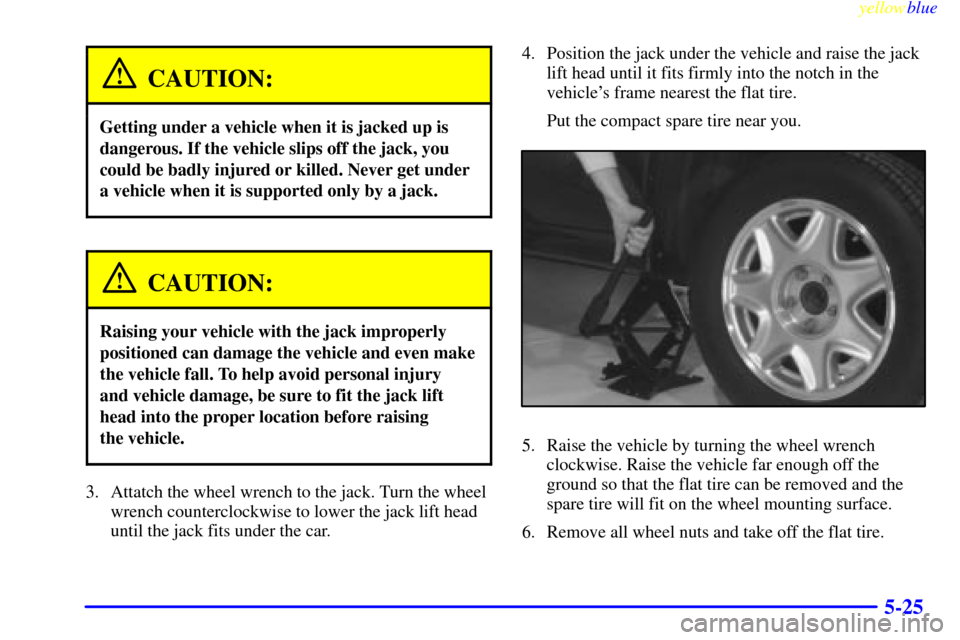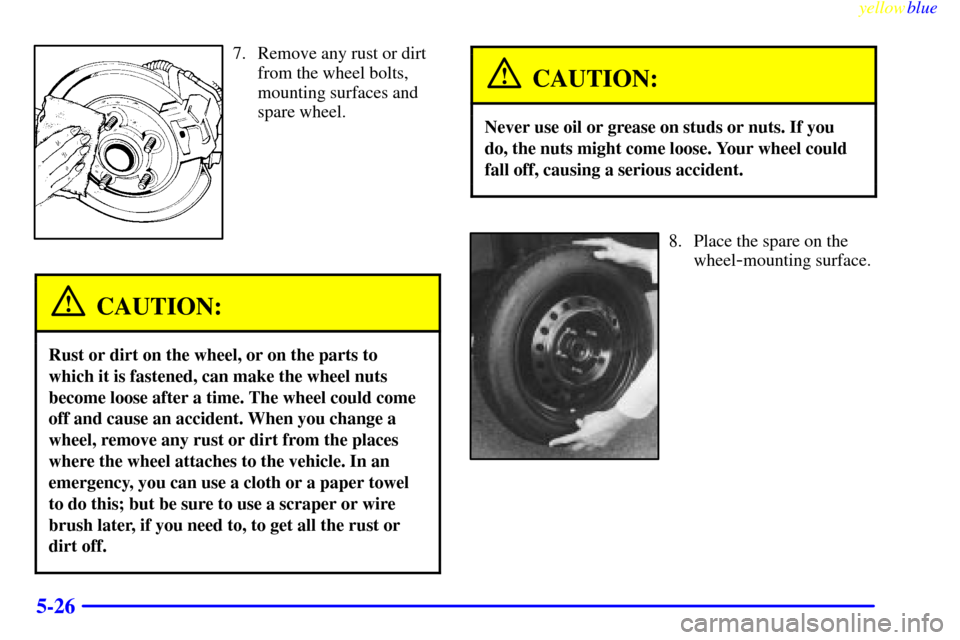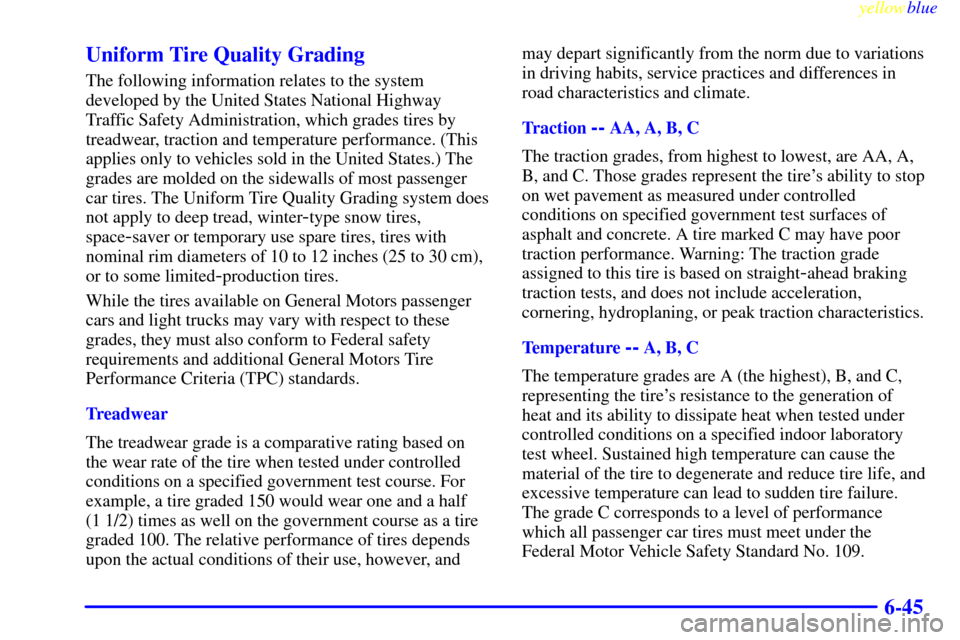spare wheel CADILLAC ELDORADO 1999 10.G Owners Manual
[x] Cancel search | Manufacturer: CADILLAC, Model Year: 1999, Model line: ELDORADO, Model: CADILLAC ELDORADO 1999 10.GPages: 344, PDF Size: 2.66 MB
Page 237 of 344

yellowblue
5-23 Removing the Wheel Cover
There is a center wheel cover on the aluminum wheel.
Using the flat end of the wheel wrench, gently pry the
wheel cover off. Be careful not to scratch the aluminum
wheel edge and don't try to remove it with your hands.
Removing the Flat Tire and Installing the
Spare Tire
1. Using the wheel wrench, loosen all the wheel nuts.
Don't remove them yet.
Page 239 of 344

yellowblue
5-25
CAUTION:
Getting under a vehicle when it is jacked up is
dangerous. If the vehicle slips off the jack, you
could be badly injured or killed. Never get under
a vehicle when it is supported only by a jack.
CAUTION:
Raising your vehicle with the jack improperly
positioned can damage the vehicle and even make
the vehicle fall. To help avoid personal injury
and vehicle damage, be sure to fit the jack lift
head into the proper location before raising
the vehicle.
3. Attatch the wheel wrench to the jack. Turn the wheel
wrench counterclockwise to lower the jack lift head
until the jack fits under the car.4. Position the jack under the vehicle and raise the jack
lift head until it fits firmly into the notch in the
vehicle's frame nearest the flat tire.
Put the compact spare tire near you.
5. Raise the vehicle by turning the wheel wrench
clockwise. Raise the vehicle far enough off the
ground so that the flat tire can be removed and the
spare tire will fit on the wheel mounting surface.
6. Remove all wheel nuts and take off the flat tire.
Page 240 of 344

yellowblue
5-26
7. Remove any rust or dirt
from the wheel bolts,
mounting surfaces and
spare wheel.
CAUTION:
Rust or dirt on the wheel, or on the parts to
which it is fastened, can make the wheel nuts
become loose after a time. The wheel could come
off and cause an accident. When you change a
wheel, remove any rust or dirt from the places
where the wheel attaches to the vehicle. In an
emergency, you can use a cloth or a paper towel
to do this; but be sure to use a scraper or wire
brush later, if you need to, to get all the rust or
dirt off.
CAUTION:
Never use oil or grease on studs or nuts. If you
do, the nuts might come loose. Your wheel could
fall off, causing a serious accident.
8. Place the spare on the
wheel
-mounting surface.
Page 242 of 344

yellowblue
5-28
11. Tighten the wheel nuts
firmly in a crisscross
sequence as shown.
CAUTION:
Incorrect wheel nuts or improperly tightened
wheel nuts can cause the wheel to become loose
and even come off. This could lead to an accident.
Be sure to use the correct wheel nuts. If you have
to replace them, be sure to get new GM original
equipment wheel nuts.
Stop somewhere as soon as you can and have
the nuts tightened with a torque wrench to
100 lb
-ft (140 N´m).
NOTICE:
Improperly tightened wheel nuts can lead to
brake pulsation and rotor damage. To avoid
expensive brake repairs, evenly tighten the wheel
nuts in the proper sequence and to the proper
torque specification.
Don't try to put a wheel cover on your compact spare
tire. It won't fit. Store the wheel cover in the trunk
until you have the flat tire repaired or replaced.
NOTICE:
Wheel covers won't fit on your compact spare. If
you try to put a wheel cover on your compact
spare, you could damage the cover or the
compact spare.
Page 245 of 344

yellowblue
5-31
Compact Spare Tire
Although the compact spare tire was fully inflated when
your vehicle was new, it can lose air after a time.
Check the inflation pressure regularly. It should be
60 psi (420 kPa).
After installing the compact spare on your vehicle, you
should stop as soon as possible and make sure your
spare tire is correctly inflated. The compact spare is
made to perform well at speeds up to 65 mph
(105 km/h) for distances up to 3,000 miles (5 000 km),
so you can finish your trip and have your full
-size tire
repaired or replaced where you want. Of course, it's best
to replace your spare with a full
-size tire as soon as you
can. Your spare will last longer and be in good shape in
case you need it again.
NOTICE:
When the compact spare is installed, don't take
your vehicle through an automatic car wash with
guide rails. The compact spare can get caught on
the rails. That can damage the tire and wheel,
and maybe other parts of your vehicle.
Don't use your compact spare on other vehicles.
And don't mix your compact spare tire or wheel with
other wheels or tires. They won't fit. Keep your spare
tire and its wheel together.
NOTICE:
Tire chains won't fit your compact spare. Using
them can damage your vehicle and can damage
the chains too. Don't use tire chains on your
compact spare.
Page 288 of 344

yellowblue
6-42
When to Check
Check your tires once a month or more.
Don't forget your compact spare tire. It should be at
60 psi (420 kPa).
How to Check
Use a good quality pocket
-type gage to check tire
pressure. You can't tell if your tires are properly inflated
simply by looking at them. Radial tires may look
properly inflated even when they're underinflated.
Be sure to put the valve caps back on the valve
stems. They help prevent leaks by keeping out dirt
and moisture.
Tire Inspection and Rotation
Tires should be rotated every 6,000 to 8,000 miles
(10 000 to 13 000 km). Any time you notice unusual
wear, rotate your tires as soon as possible and check
wheel alignment. Also check for damaged tires or
wheels. See ªWhen It's Time for New Tiresº and
ªWheel Replacementº later in this section for
more information.The purpose of regular rotation is to achieve more
uniform wear for all tires on the vehicle. The first
rotation is the most important. See ªScheduled
Maintenance Servicesº in the Maintenance Schedule
booklet for scheduled rotation intervals.
When rotating your tires, always use the correct rotation
pattern shown here.
Don't include the compact spare tire in your tire rotation.
After the tires have been rotated, adjust the front and rear
inflation pressures as shown on the Tire
-Loading
Information label. Make certain that all wheel nuts are
properly tightened. See ªWheel Nut Torqueº in the Index.
Page 290 of 344

yellowblue
6-44 Buying New Tires
To find out what kind and size of tires you need, look at
the Tire
-Loading Information label.
The tires installed on your vehicle when it was new had
a Tire Performance Criteria Specification (TPC Spec)
number on each tire's sidewall. When you get new tires,
get ones with that same TPC Spec number. That way
your vehicle will continue to have tires that are designed
to give proper endurance, handling, speed rating,
traction, ride and other things during normal service on
your vehicle. If your tires have an all
-season tread
design, the TPC number will be followed by an ªMSº
(for mud and snow).
If you ever replace your tires with those not having a
TPC Spec number, make sure they are the same size,
load range, speed rating and construction type (bias,
bias
-belted or radial) as your original tires.
CAUTION:
Mixing tires could cause you to lose control while
driving. If you mix tires of different sizes or types
(radial and bias
-belted tires), the vehicle may not
handle properly, and you could have a crash.
Using tires of different sizes may also cause
damage to your vehicle. Be sure to use the same
size and type tires on all wheels.
It's all right to drive with your compact spare,
though. It was developed for use on your vehicle.
CAUTION:
If you use bias-ply tires on your vehicle, the
wheel rim flanges could develop cracks after
many miles of driving. A tire and/or wheel could
fail suddenly, causing a crash. Use only radial
-ply
tires with the wheels on your vehicle.
Page 291 of 344

yellowblue
6-45 Uniform Tire Quality Grading
The following information relates to the system
developed by the United States National Highway
Traffic Safety Administration, which grades tires by
treadwear, traction and temperature performance. (This
applies only to vehicles sold in the United States.) The
grades are molded on the sidewalls of most passenger
car tires. The Uniform Tire Quality Grading system does
not apply to deep tread, winter
-type snow tires,
space
-saver or temporary use spare tires, tires with
nominal rim diameters of 10 to 12 inches (25 to 30 cm),
or to some limited
-production tires.
While the tires available on General Motors passenger
cars and light trucks may vary with respect to these
grades, they must also conform to Federal safety
requirements and additional General Motors Tire
Performance Criteria (TPC) standards.
Treadwear
The treadwear grade is a comparative rating based on
the wear rate of the tire when tested under controlled
conditions on a specified government test course. For
example, a tire graded 150 would wear one and a half
(1 1/2) times as well on the government course as a tire
graded 100. The relative performance of tires depends
upon the actual conditions of their use, however, andmay depart significantly from the norm due to variations
in driving habits, service practices and differences in
road characteristics and climate.
Traction
-- AA, A, B, C
The traction grades, from highest to lowest, are AA, A,
B, and C. Those grades represent the tire's ability to stop
on wet pavement as measured under controlled
conditions on specified government test surfaces of
asphalt and concrete. A tire marked C may have poor
traction performance. Warning: The traction grade
assigned to this tire is based on straight
-ahead braking
traction tests, and does not include acceleration,
cornering, hydroplaning, or peak traction characteristics.
Temperature
-- A, B, C
The temperature grades are A (the highest), B, and C,
representing the tire's resistance to the generation of
heat and its ability to dissipate heat when tested under
controlled conditions on a specified indoor laboratory
test wheel. Sustained high temperature can cause the
material of the tire to degenerate and reduce tire life, and
excessive temperature can lead to sudden tire failure.
The grade C corresponds to a level of performance
which all passenger car tires must meet under the
Federal Motor Vehicle Safety Standard No. 109.
Page 309 of 344

yellowblue
6-63
Fuse Usage
COMFORT CD Player, Remote Keyless Entry
(RKE), Controlled Power Relay,
Air Control Module (ACM), PZM
AMP (Bose
Only) (Optional)Right and Left Hand Bose Relay,
Right and Left Front Speakers
(On Door), Right and Left Rear
Speakers, Bose Amplifier
PZM Passenger Zone Module (PZM)
RADIO/PHONE Radio Receiver, Radio Interface
Module (RIM) (Bose Only),
Phone, DAB Relay, Trunk Release
Relay, Fuel Door Release Relay,
High/Low
-Beam Relay
CLUSTER Steering Wheel Controls, Cluster
ACC PZM, Electrochromic Mirror,
Rain Sensor (Optional),
Accessory Relay
SPARE Not Used
HTD MIR Right and Left Outside
Heated MirrorFuse Usage
HTD SEAT R Passenger Heated Seat
Relay (Optional)
HTD SEAT L Driver Heated Seat
Relay (Optional)
PULL DOWN Trunk Pull
-Down Motor
HDLP WASH Headlamp Washers
ANTENNA Power Mast Antenna
RSS Damper Relay (ETC Only)
CONVENC Trunk Release Relay, Trunk
Release Solenoid, Fuel Door
Release Relay, Fuel Filler Door
Release Solenoid, Door Lock
Relay, Left Front Door Motors,
PZM, Door Unlock Relay
BATT Driver and Passenger Seat Lumbar
Switch (Optional), Driver and
Passenger Seat Belt Comfort
Solenoid, Memory Seat Module
RSS Road Sensing Suspension (RSS)
Module (ETC Only)
Page 333 of 344

yellowblue
8-3
Check Fuel Gauge Message 2-84 . . . . . . . . . . . . . . . . . . . . . . .
Check Gas Cap Message 2-84 . . . . . . . . . . . . . . . . . . . . . . . . .
Check Oil Level Message 2-84 . . . . . . . . . . . . . . . . . . . . . . . .
Check Washer Fluid Message 2-84 . . . . . . . . . . . . . . . . . . . . .
Checking Engine Oil 6-12 . . . . . . . . . . . . . . . . . . . . . . . . . . . .
Checking Your Restraint Systems 1-49 . . . . . . . . . . . . . . . . . .
Chemical Paint Spotting 6-53 . . . . . . . . . . . . . . . . . . . . . . . . . .
Child Restraints 1-35 . . . . . . . . . . . . . . . . . . . . . . . . . . . . . . . .
Securing in a Rear Outside Seat Position 1-40 . . . . . . . . . . .
Securing in the Center Rear Seat Position 1-42 . . . . . . . . . .
Securing in the Right Front Seat Position 1-44 . . . . . . . . . .
Top Strap 1-40 . . . . . . . . . . . . . . . . . . . . . . . . . . . . . . . . . . .
Where to Put 1-39 . . . . . . . . . . . . . . . . . . . . . . . . . . . . . . . .
CHMSL 6-36 . . . . . . . . . . . . . . . . . . . . . . . . . . . . . . . . . . . . . .
Chrome-Plated Wheels, Cleaning 6-52 . . . . . . . . . . . . . . . . . .
Cigarette Lighter 2-50 . . . . . . . . . . . . . . . . . . . . . . . . . . . . . . .
Circuit Breakers and Fuses 6-59 . . . . . . . . . . . . . . . . . . . . . . .
City Driving 4-19 . . . . . . . . . . . . . . . . . . . . . . . . . . . . . . . . . . .
Cleaning
Aluminum or Chrome
-Plated Wheels 6-52 . . . . . . . . . . . . .
Exterior Lamps/Lenses 6-51 . . . . . . . . . . . . . . . . . . . . . . . .
Fabric/Carpet 6-48 . . . . . . . . . . . . . . . . . . . . . . . . . . . . . . . .
Glass Surfaces 6-50 . . . . . . . . . . . . . . . . . . . . . . . . . . . . . . .
Inside of Your Vehicle 6-48 . . . . . . . . . . . . . . . . . . . . . . . . .
Instrument Panel 6-49 . . . . . . . . . . . . . . . . . . . . . . . . . . . . .
Interior Plastic Components 6-49 . . . . . . . . . . . . . . . . . . . . .
Leather 6-49 . . . . . . . . . . . . . . . . . . . . . . . . . . . . . . . . . . . . .
Outside of the Windshield and Wiper Blades 6-50 . . . . . . .
Outside of Your Vehicle 6-51 . . . . . . . . . . . . . . . . . . . . . . . .
Speaker Covers 6-49 . . . . . . . . . . . . . . . . . . . . . . . . . . . . . . Tires 6
-52 . . . . . . . . . . . . . . . . . . . . . . . . . . . . . . . . . . . . . . .
Vinyl 6-49 . . . . . . . . . . . . . . . . . . . . . . . . . . . . . . . . . . . . . . .
Wheels 6-52 . . . . . . . . . . . . . . . . . . . . . . . . . . . . . . . . . . . . .
Wood Panels 6-49 . . . . . . . . . . . . . . . . . . . . . . . . . . . . . . . . .
Climate Control Panel 3-2 . . . . . . . . . . . . . . . . . . . . . . . . . . . .
Climate Control Personalization 3-9 . . . . . . . . . . . . . . . . . . . .
Climate Control, Steering Wheel Controls 3-9 . . . . . . . . . . . .
Clock, Setting the 3-9 . . . . . . . . . . . . . . . . . . . . . . . . . . . . . . . .
Cluster, Instrument Panel 2-58 . . . . . . . . . . . . . . . . . . . . . . . . .
Comfort Controls 3-2 . . . . . . . . . . . . . . . . . . . . . . . . . . . . . . . .
Comfort Controls and Radio System Personalization 2-84 . . .
Compact Disc Care 3-31 . . . . . . . . . . . . . . . . . . . . . . . . . . . . .
Compact Disc Player Care 3-31 . . . . . . . . . . . . . . . . . . . . . . . .
Compact Disc Players 3-21 . . . . . . . . . . . . . . . . . . . . . . . . . . .
Compact Spare Tire 5-31 . . . . . . . . . . . . . . . . . . . . . . . . . . . . .
Compartments, Storage 2-49 . . . . . . . . . . . . . . . . . . . . . . . . . .
Compass, Rearview Mirror with 2-45 . . . . . . . . . . . . . . . . . . .
Console, Overhead 2-49 . . . . . . . . . . . . . . . . . . . . . . . . . . . . . .
Console Shift Lever 2-27 . . . . . . . . . . . . . . . . . . . . . . . . . . . . .
Continuous Variable Road Sensing
Suspension (CVRSS) 2
-84 . . . . . . . . . . . . . . . . . . . . . . . . . .
Control of a Vehicle 4-5 . . . . . . . . . . . . . . . . . . . . . . . . . . . . . .
Control System, Traction 4-9 . . . . . . . . . . . . . . . . . . . . . . . . . .
Convenience Net 2-50 . . . . . . . . . . . . . . . . . . . . . . . . . . . . . . .
Convex Outside Mirror 2-48 . . . . . . . . . . . . . . . . . . . . . . . . . .
Coolant 6-23 . . . . . . . . . . . . . . . . . . . . . . . . . . . . . . . . . . . . . . .
Heater, Engine 2-20 . . . . . . . . . . . . . . . . . . . . . . . . . . . . . . .
Surge Tank 5-13 . . . . . . . . . . . . . . . . . . . . . . . . . . . . . . . . . .
Cooling System 5-13 . . . . . . . . . . . . . . . . . . . . . . . . . . . . . . . .
Cornering Lamps 2-42 . . . . . . . . . . . . . . . . . . . . . . . . . . . . . . .